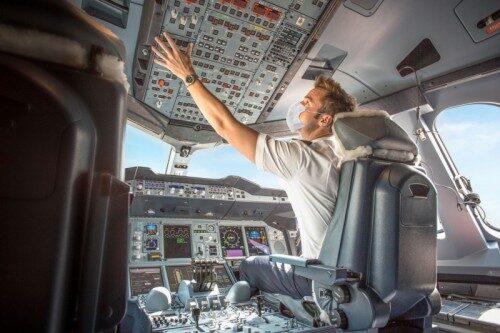Airlines
European regulator rules out single-pilot flying by 2030

A single pilot would be flying passenger jets instead of two, according to airlines and regulators. It would save costs and relieve pressure from crew shortages, but some people find it disturbing to place such authority in the hands of a single individual.
The European Union Aviation Safety Agency has also been collaborating with aircraft manufacturers to develop guidelines for regulating solo flights and to assess how they would function. EASA stated that these services might begin in 2027.
The regulator is considering a proposal from European aircraft manufacturers Airbus SE and Dassault Aviation for solo flight during the cruise phase, which is less taxing than takeoff and landing but still requires at least two pilots to be in the cockpit.
Since the relaxing of regulations would permit pilots to rest during lengthy flights without replacements being on board, the aviation industry wants solo flying to help ease a challenging labor crisis.
An earlier industry plan for sole-pilot flying by 2030 was “absolutely not practical,” according to Andrea Boiardi, a manager with the regulator (EASA), because automation had not advanced enough and solo flight required a degree of safety similar to current operations.
The International Civil Aviation Organization, the individual airlines, and their pilot unions must all approve solo flying, even when on a cruise. Early this year, the U.N. organization is anticipated to start studying the issue.
Malaysia regains US FAA’s Category 1 safety rating(Opens in a new browser tab)
Boiardi stated that only the most sophisticated aircraft, outfitted with a higher level of safety than required by basic certification standards, could be utilized for solo flight in cruise. They might include Boeing 777Xs and 787s as well as Airbus A350s. In the first in-depth interview, EASA has given on the subject. EASA was soliciting opinions on the issue from airlines and pilots in a process that was anticipated to end in March.
Eventually, long-haul crews that currently required three or four pilots might be reduced to two, with both in the cockpit for takeoff and landing. If safety was established. However, even limited solo flying is causing friction between airlines and public unease while also igniting a growing opposition among pilot organizations like the European Cockpit Association.

Airlines
Sanctions & Engine Issues Ground Half of Russia’s A320neo fleet

Russia’s aviation sector, already strained by Western sanctions, faces another setback as nearly half of its Airbus A320neo family aircraft are grounded due to unresolved engine issues.
This development highlights the growing challenges for russia commercial aircraft in maintaining their fleets under the weight of global restrictions and limited access to spare parts.
Out of the 66 Airbus A320neo and A321neo jets in Russia, 34 are now out of service, according to the Kommersant business newspaper. These planes are powered by engines manufactured by Pratt & Whitney, a subsidiary of RTX Corporation.
DAMAC Air: Dubai’s New Luxury Airline Offers Free Flights for Registration
The engines are affected by a previously identified defect in the metal used for certain parts, prompting accelerated inspections and maintenance.
Sanctions have compounded the issue, blocking the supply of essential components from major manufacturers like Boeing and Airbus. Without proper maintenance, experts warn that these aircraft may face decommissioning as early as 2026.
COMAC Unveils Plans for the C929 to Rival Airbus and Boeing
Airlines like S7, which operates a significant portion of these grounded jets, plan to conserve the engines for future use during peak travel seasons. However, reports suggest that over 20 of S7’s Airbus planes have engines that have already reached the end of their operational lifespan. Recently, russia seeks assistance from kazakhstan’s airlines to bolster its domestic flights.
While some A320neo and A321neo planes in Russia are equipped with French-made LEAP engines, which are seen as less problematic, the challenges remain daunting.
The situation underscores the long-term impact of sanctions on Russia’s aviation sector and the increasing difficulties in keeping its modern fleets operational.
-

 Aviation2 months ago
Aviation2 months agoMicrosoft Flight Simulator Raises $3 Million to Bring Back the An-225 Mriya
-

 Airlines2 months ago
Airlines2 months agoQantas Engineers Stage Walkout Over Cost of Living Concerns
-

 Airlines2 months ago
Airlines2 months agoQatar Citizens Can Travel to the United States Without a Visa
-

 Aviation2 months ago
Aviation2 months agoQatar Airways bans these new Electronic Devices on plane
-

 Airlines2 months ago
Airlines2 months agoJapan Airlines Rolls Out Free Domestic Flights to International Passengers
-

 Defence2 months ago
Defence2 months agoWhich Country Has the Largest Fleet of Fighter Aircraft?
-

 Airport2 months ago
Airport2 months agoWestern Sydney Airport Welcomes Its First Plane After 6 Years of construction
-

 Aviation2 months ago
Aviation2 months agoDid you know ? Once Boeing 747 carried 1088 passenger in 1991








